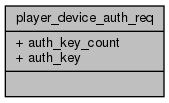Configuration request: Authentication. More...
#include <player_interfaces.h>

Detailed Description
Configuration request: Authentication.
- Todo:
- Add support for this mechanism to libplayertcp. Right now, it's disabled.
If server authentication has been enabled (by providing '-key <key>' on the command-line); then each client must authenticate itself before otherwise interacting with the server. To authenticate, send a request with this format.
If the key matches the server's key then the client is authenticated, the server will reply with a zero-length acknowledgement, and the client can continue with other operations. If the key does not match, or if the client attempts any other server interactions before authenticating, then the connection will be closed immediately. It is only necessary to authenticate each client once.
Note that this support for authentication is NOT a security mechanism. The keys are always in plain text, both in memory and when transmitted over the network; further, since the key is given on the command-line, there is a very good chance that you can find it in plain text in the process table (in Linux try 'ps -ax | grep player'). Thus you should not use an important password as your key, nor should you rely on Player authentication to prevent bad guys from driving your robots (use a firewall instead). Rather, authentication was introduced into Player to prevent accidentally connecting one's client program to someone else's robot. This kind of accident occurs primarily when Stage is running in a multi-user environment. In this case it is very likely that there is a Player server listening on port 6665, and clients will generally connect to that port by default, unless a specific option is given.
This mechanism was never really used, and may be removed.
Public Attributes | |
| uint32_t | auth_key_count |
| Length of key. | |
| uint8_t | auth_key [PLAYER_KEYLEN] |
| The authentication key. | |
The documentation for this struct was generated from the following file:

